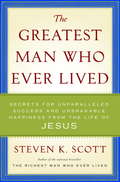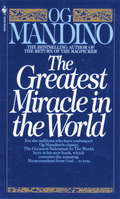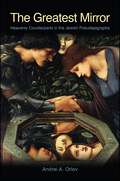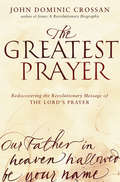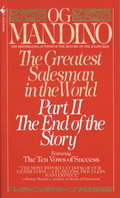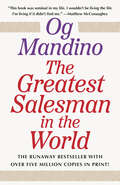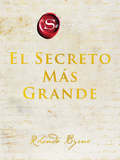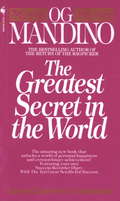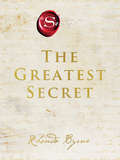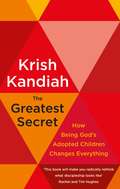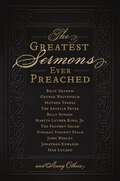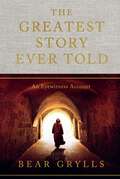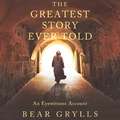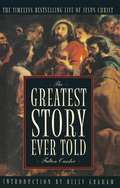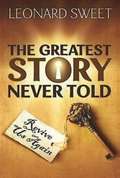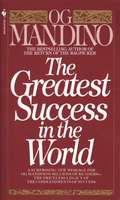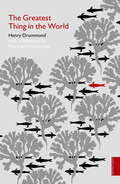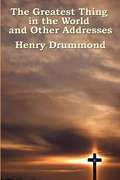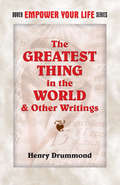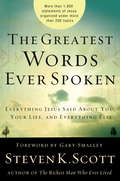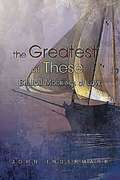- Table View
- List View
The Greatest Man Who Ever Lived
by Watch Tower Bible and Tract Society of New York Inc.How do you measure the greatness of a man? By his military genius? his physical strength? his mental prowess? The historian H. G. Wells said that a man's greatness can be measured by what he leaves to grow, and whether he started others to think along fresh lines with a vigor that persisted after him.' Wells, although not claiming to be a Christian, acknowledged: "By this test Jesus stands first." Alexander the Great, Charlemagne (styled "the Great" even in his own lifetime), and Napoleon Bonaparte were powerful rulers. By their formidable presence, they wielded great influence over those they commanded. Yet, Napoleon is reported to have said: "Jesus Christ has influenced and commanded His subjects without His visible bodily presence." By his dynamic teachings and by the way he lived in harmony with them, Jesus has powerfully affected the lives of people for nearly two thousand years. As one writer aptly expressed it: "All the armies that ever marched, and all the navies that ever were built, and all the parliaments that ever sat, all the kings that ever reigned, put together have not affected the life of man upon this earth as powerfully." NONE
The Greatest Man Who Ever Lived: The Wisdom of Jesus in Achieving Unparalleled Success and Unshakable Happiness
by Steven K. ScottJust as the sun blinds our eyes to a sky filled with stars, Jesus’ deity can blind us to the unseen riches of His humanity. In The Greatest Man Who Ever Lived, Steven K. Scott reveals the hidden treasures to be found in Christ’s life as a human. When you learn from Jesus’ life on earth, your own life will be propelled to a whole new level of achievement, happiness, and success. As you look at Jesus’ life, you will learn how to: •Find new meanings that will raise your life to new heights.•Develop missions that will produce greater creativity and productivity.•Communicate messages that will move the minds and hearts of your listeners.•Act in a manner that attracts others, increases your value, and heightens your self-esteem. •Adopt a method that accelerates extraordinary success. •Discover your incredible worth. •Give and receive a type of love that is truer than any you have experienced before.Let the greatest Man who ever lived turn your purpose-driven life into a purpose-accomplished life!
The Greatest Miracle in the World
by Og Mandino'The greatest miracle in the world' contains the Memorandum from God to you. A great inspirational writer tells his story - a narrative that will hold you spellbound as it reveals exciting new secrets for your personal happiness and success.
The Greatest Mirror: Heavenly Counterparts in the Jewish Pseudepigrapha
by Andrei A. OrlovThe idea of a heavenly double—an angelic twin of an earthbound human—can be found in Christian, Manichaean, Islamic, and Kabbalistic traditions. Scholars have long traced the lineage of these ideas to Greco-Roman and Iranian sources. In The Greatest Mirror, Andrei A. Orlov shows that heavenly twin imagery drew in large part from early Jewish writings. The Jewish pseudepigrapha—books from the Second Temple period that were attributed to biblical figures but excluded from the Hebrew Bible—contain accounts of heavenly twins in the form of spirits, images, faces, children, mirrors, and angels of the Presence. Orlov provides a comprehensive analysis of these traditions in their full historical and interpretive complexity. He focuses on heavenly alter egos of Enoch, Moses, Jacob, Joseph, and Aseneth in often neglected books, including Animal Apocalypse, Book of the Watchers, 2 Enoch, Ladder of Jacob, and Joseph and Aseneth, some of which are preserved solely in the Slavonic language.
The Greatest Prayer: Rediscovering the Revolutionary Message of the Lord's Prayer
by John Dominic CrossanEvery Sunday, the Lord's Prayer echoes in churches around the world. It is an indisputable principle of Christian faith. It is the way Jesus taught his followers to pray and distills the most essential beliefs required of every one of the world's 2.5 billion Christians. In The Greatest Prayer, our foremost Jesus scholar explores this foundational prayer line by line for the richest and fullest understanding of a prayer every Christian knows by heart. An expert on the historical Jesus, Crossan provides just the right amount of history, scholarship, and detail for us to rediscover why this seemingly simple prayer sparked a revolution. Addressing issues of God's will for us and our response, our responsibilities to one another and to the earth, the theology of our daily bread, the moral responsibilities that come with money, our nation-states, and God's kingdom, Crossan reveals the enduring meaning and universal significance of the only prayer Jesus ever taught.
The Greatest Salesman in the World II: The End of the Story (The Greatest Salesman in the World #2)
by Og MandinoWhat you are today is not important...for in this runaway bestseller you will learn how to change your life by applying the secrets you are about to discover in the ancient scrolls.From the Paperback edition.
The Greatest Salesman in the World: Transform Your Life And Find True Fulfillment With The Priceless Wisdom Revealed Within (The Greatest Salesman in the World)
by Og Mandino&“This book was seminal in my life. I wouldn&’t be living the life I&’m living if it didn&’t find me.&”—Matthew McConaugheyTen ancient scrolls reveal priceless wisdom for changing your life in this evergreen classic with more than five million copies in print.A timeless fable with profoundly modern lessons, The Greatest Salesman in the World is both a road map to salesmanship and a heartfelt tale that redefines the meaning of success.As a young camel boy in Jerusalem, Hafid dreams of becoming more. Witnessing the great empires of tradesmanship that others have grown, he desires to do the same—to become not only a salesman, but the greatest salesman in the world. Desperate to prove himself, he approaches the best merchant he knows, who sets him an impossible task—a task that takes him on an unforgettable journey involving a red cloak, a barn in Bethlehem, and ten scrolls that will change his life.Each scroll touches upon perennially valuable lessons: persisting against the odds, mastering emotions, embracing joy, and creating good habits. Through the story of Hafid and his ten scrolls, The Greatest Salesman in the World guides readers through a philosophy for getting the most out of life—starting right now.
The Greatest Secret \ El Secreto Más Grande (Spanish edition)
by Rhonda ByrneAuthor of the worldwide bestseller The Secret, Rhonda Byrne’s long-awaited major new book offers readers a path to end pain and suffering endured, and shines a light on a future without anxiety or fear.The Greatest Secret, the long-awaited major work by Rhonda Byrne, lays out the next quantum leap in a journey that will take the reader beyond the material world and into the spiritual realm, where all possibilities exist. The book reflects Rhonda’s own journey, and shares the most direct way out for those experiencing hardship and the path to end pain and suffering endured by so many, and shines a light on a future without anxiety or fear. Filled with accessible practices that can be immediately put to use and profound revelations that take the reader on an incomparable journey, Rhonda’s discovery is reinforced throughout by the revelatory words of sages from around the world, past and present.
The Greatest Secret in the World: 1995 Edition (Collection Motivation Et Épanouissement Personnel)
by Og MandinoWhat is 'the greatest secret in the world'? You won't discover it, although it's spelled out for you, unless you give yourself completely to this book and let its message change your life...for the better.
The Greatest Secret: And It's Easier Than You Think, Books 1 Through 5, The Greatest Secret Edtion (The Secret)
by Rhonda ByrneNew York Times BestsellerFrom Rhonda Byrne, the author of the worldwide phenomenon The Secret, comes The Greatest Secret—a long-awaited major new work that offers revelations and practices to end suffering and discover lasting happiness.Ancient traditions knew that to hide a secret it should be put in plain sight, where no-one will think to look for it. Billions of people on our planet have searched—but few have discovered the truth. Those few are completely free from negativity and live in permanent peace and happiness.For the rest of us, whether we realize it or not, we’ve been in search of this truth unceasingly every single day of our lives. What secret can possibly be so lifechanging? What single discovery offers a direct path to end suffering and to live a life of deep joy? The Greatest Secret is a quantum leap that will take the reader beyond the material world and into the spiritual realm, where all possibilities exist. Inside The Greatest Secret, you’ll find:· Profound wisdom from spiritual teachers from around the world, past and present, who have discovered the greatest secret.· Healing practices that can be put to use immediately to dissolve fears, uncertainty, anxiety, and pain.· The ultimate key to end suffering and discover lasting happiness.“The Secret showed you how to create anything you want to be, do, or have. Nothing has changed - it is as true today as it ever was. This book reveals the greatest discovery a human being can ever make, and shows you the way out of negativity, problems, and what you don’t want, to a life of permanent happiness and bliss.”—From The Greatest Secret
The Greatest Secret: How being God's adopted children changes everything
by Krish Kandiah'This book will make you radically rethink what discipleship looks like' - Rachel and Tim Hughes'It is refreshing to read a Christian book that is powerful in its vulnerability, rawness, and ultimately, its hope. - Chine McDonald'Theologian Krish Kandiah had been a missionary, a youth worker and a pastor - but for all his Christian qualifications, he found himself lost in his relationship with God.That was until he rediscovered his Christian faith through a simple secret: he was adopted by God.Interweaving his personal story with theological insight, Krish shows us how the doctrine of adoption helps us to understand everything; it gives us purpose and power, perspective and peace.This book is for anyone seeking new depth and intimacy with the God by discovering the greatest secret woven throughout the pages of the whole Bible.
The Greatest Sermons Ever Preached
by Thomas NelsonThis book is a collection of sermons from the world's greatest religious thinkers. From the teachings of: Jesus Martin Luther King Jr. George Whitfield Jonathan Edwards Moses Mother Teresa and many more...These classic readings will provide devotional thoughts, inspirational messages, and helpful resources for any believer.After completing this book, readers will: have a sense of peace and inspiration that comes from devotional reading be motivated by the greatest sermons from the history's great teachers have a great resource for powerful sermons and anecdotes at their fingertips
The Greatest Story Ever Told
by Bear GryllsThe incredible true story about a Galilean stonemason who changed the course of the world forever.Beautifully told through the eyewitness accounts of those who knew him best.This real-life story will never leave you.This is the incredible true story of a Galilean stonemason who changed the course of the world forever. He lived and died over 2,000 years ago, fulfilling expectations that existed long before his birth.His birth had been mystically foretold by astrologers for hundreds of years, yet the rulers of his day dreaded his coming.This humble builder-teacher became a magnet for the poor and down trodden, a symbol of love and mercy, who transformed the lives and restored the health and purpose in all who encountered him.The local elite and governing rulers eventually tortured him and put him to death in the most violent and public of ways. Yet that was only the beginning...In the years since, billions of people have dedicated their lives to this man and have testified to his divinity and truth. To others, he is little more than another rebel who was killed by one of the most brutal empires in human history.How we each respond to this story dictates the course of our lives. And it all rests on the great mystery that occurred at the end of his life - a supernatural event that he had predicted with utter clarity.Did this humble man tell the truth? Could one man really be the focal point of the universe?Read on to find out, and get ready to make up your own mind. Wherever this journey takes you, this is arguably:THE GREATEST STORY EVER TOLD.
The Greatest Story Ever Told
by Bear GryllsThe incredible true story about a Galilean stonemason who changed the course of the world forever.Beautifully told through the eyewitness accounts of those who knew him best.This real-life story will never leave you.This is the incredible true story of a Galilean stonemason who changed the course of the world forever. He lived and died over 2,000 years ago, fulfilling expectations that existed long before his birth.His birth had been mystically foretold by astrologers for hundreds of years, yet the rulers of his day dreaded his coming.This humble builder-teacher became a magnet for the poor and down trodden, a symbol of love and mercy, who transformed the lives and restored the health and purpose in all who encountered him.The local elite and governing rulers eventually tortured him and put him to death in the most violent and public of ways. Yet that was only the beginning...In the years since, billions of people have dedicated their lives to this man and have testified to his divinity and truth. To others, he is little more than another rebel who was killed by one of the most brutal empires in human history.How we each respond to this story dictates the course of our lives. And it all rests on the great mystery that occurred at the end of his life - a supernatural event that he had predicted with utter clarity.Did this humble man tell the truth? Could one man really be the focal point of the universe?Read on to find out, and get ready to make up your own mind. Wherever this journey takes you, this is arguably:THE GREATEST STORY EVER TOLD.
The Greatest Story Ever Told
by Bear GryllsThe incredible true story about a Galilean stonemason who changed the course of the world forever.Beautifully told through the eyewitness accounts of those who knew him best.This real-life story will never leave you.This is the incredible true story of a Galilean stonemason who changed the course of the world forever. He lived and died over 2,000 years ago, fulfilling expectations that existed long before his birth.His birth had been mystically foretold by astrologers for hundreds of years, yet the rulers of his day dreaded his coming.This humble builder-teacher became a magnet for the poor and down trodden, a symbol of love and mercy, who transformed the lives and restored the health and purpose in all who encountered him.The local elite and governing rulers eventually tortured him and put him to death in the most violent and public of ways. Yet that was only the beginning...In the years since, billions of people have dedicated their lives to this man and have testified to his divinity and truth. To others, he is little more than another rebel who was killed by one of the most brutal empires in human history.How we each respond to this story dictates the course of our lives. And it all rests on the great mystery that occurred at the end of his life - a supernatural event that he had predicted with utter clarity.Did this humble man tell the truth? Could one man really be the focal point of the universe?Read on to find out, and get ready to make up your own mind. Wherever this journey takes you, this is arguably:THE GREATEST STORY EVER TOLD.
The Greatest Story Ever Told
by Fulton OurslerFulton Oursler's narrative of the life of Jesus Christ.
The Greatest Story Never Told: Revive Us Again
by Leonard SweetGod raises up Methodists for such a time as this. Here is a ditty Len Sweet’s Methodist grandfather used to sing: A Methodist, a Methodist will I be A Methodist will I die. I’ve been baptized in the Methodist way And I’ll live on the Methodist side. What "genius" of Methodism inspired this kind of love and loyalty in the earlier years of the faith? What did it mean to live in "the Methodist way" and to die on "the Methodist side?" Perhaps it is time to resurrect a neo-Wesleyan identity and to challenge the prevailing "one-calorie Methodism" that characterizes so much of our tribe today. What makes a Methodist? How can we re-ignite the spark of genius that motivated such commitment in our cloud of witnesses? The essence of Methodism’s genius resides in two famous Wesleyan mantras: "heart strangely warmed" (inward experiences with a fire in the heart) and "the world is our parish" (outward experiences with waterfalls of cutting-edge intelligence). For Wesley, internal combustion, the former, led to external combustion, the latter. In the 18th century, Methodists in general (and in their younger years, the Wesley brothers themselves) were accused of being too "sexy." What else could all those "love feasts" and "strangely warmed hearts" be about? Why else were all those women in positions of leadership? With this book the author hopes to bring back to life some of Methodism’s sexiness so that our current reproduction crisis can be reversed.
The Greatest Success in the World: From The Greatest Salesman In The World
by Og MandinoThrough the deeply inspirational story of one extraordinary man who lived in the time of Christ --you, too, can learn to shed failure, overcome frustration and heartbreak to achieve a rich, satisfying life of peace and guidance, you can play the game of life fearlessly -- and win. Accept his precious gift of wisdom and know the true rewards of limitless personal successFrom the Paperback edition.
The Greatest Thing in the World (Hodder Classics): An Address - Scholar's Choice Edition
by Henry Drummond'You have life before you. Once only you can live it. What is the noblest object of desire, the supreme gift to covet?' THE GREATEST THING IN THE WORLD is perhaps the most famous exposition of Paul's message of love to the Corinthian church. Scottish writer Henry Drummond wrote this short meditation on love in 1874; widely read and quoted in his lifetime, it sold over twelve million copies and remains a much-loved devotional classic today. THE GREATEST THING IN THE WORLD lays out the foundation of the gospel: that love, of God and of one another, is our highest calling. This new edition, with a foreword by Norman Drummond, is for all who seek to live a life of love.
The Greatest Thing in the World (Hodder Classics): An Address - Scholar's Choice Edition
by Henry Drummond'You have life before you. Once only you can live it. What is the noblest object of desire, the supreme gift to covet?' THE GREATEST THING IN THE WORLD is perhaps the most famous exposition of Paul's message of love to the Corinthian church. Scottish writer Henry Drummond wrote this short meditation on love in 1874; widely read and quoted in his lifetime, it sold over twelve million copies and remains a much-loved devotional classic today. THE GREATEST THING IN THE WORLD lays out the foundation of the gospel: that love, of God and of one another, is our highest calling. This new edition, with a foreword by Norman Drummond, is for all who seek to live a life of love.
The Greatest Thing in the World and Other Addresses
by Henry Drummond"We have been accustomed to be told that the greatest thing in the religious world is Faith. That great word has been the key-note for centuries of the popular religion; and we have easily learned to look upon it as the greatest thing in the world. Well, we are wrong. If we have been told that, we may miss the mark. In the 13th chapter of I Corinthians, Paul takes us to Christianity at its source; and there we see, 'the greatest of these is love.'" Included here are "Love: the Greatest Thing in the World," "Lessons from the Angelus," "Pax Vobiscum," "First! An Address to Boys," "The Changed Life, the Greatest Need of the World," and "Dealing with Doubt."
The Greatest Thing in the World and Other Writings
by Henry DrummondA 19th-century evangelist offers powerful meditations on I Corinthians 13, St. Paul's famous chapter on love. Revered by religious and secular readers alike, this well-known discourse is accompanied by additional brief essays, including: Pax Vobiscum, The Changed Life, "First!", How to Learn, What Is a Christian?, and The Study of the Bible.
The Greatest Words Ever Spoken
by Steven K. ScottScott collects in one volume all the sayings of Jesus addressing nine crucial areas of life--the sayings, teachings, and promises of Jesus on 222 topics.
The Greatest Words Ever Spoken: Everything Jesus Said About You, Your Life, and Everything Else
by Steven K. ScottEvery Word of Jesus Right at Your FingertipsHaven’t you wished you could ask Jesus any question and get his immediate help with the biggest problems you face? Now you can. For the first time ever, all of the statements Jesus made in the New Testament have been brought together and organized under more than 200 topics. When you want to know his will in a specific area of life, or you’re seeking the answer to a perplexing question, or you are desperate for his encouragement, comfort, or wisdom–you can easily find the help you need. The moment you turn to the appropriate topic heading, you will have access to the breadth of Jesus’ teaching on that subject. You can also use this book as a guide for studying Jesus’ wisdom on any topic of interest, such as prayer, forgiveness, eternity, anger, temptation, relationships, grace, or knowing God. As you immerse yourself in Jesus’ words, your life and relationships will be transformed, and your faith and spiritual passion will be renewed. Let the greatest words ever spoken bring new vision, power, and joy into your life–one statement at a time.
The Greatest of These: Biblical Moorings of Love
by John IndermarkGod is love. Love one another. We teach these to children and new Christians, but what exactly do we mean (and do they hear) by love? Our culture offers a multitude of understandings and experiences through which the meaning of love can be filtered. We in the church can become sloppy in our proclamation and embodiment of love as a result of those filterings, unless we remain grounded in the Biblical moorings of love revealed in the narratives of both the Old and New Testaments.The Greatest of These offers an extended exploration of love 's qualities in scripture. Each of the six chapters begins with a single page introduction to the chapter theme. The bulk of each chapter consists of six individual readings (2.5 to 3 pages each) that reflect on a Biblical passage related to the chapter 's theme on love. The book is written for use by individuals or groups, and a leader's guide, which is written into the book, provides for six suggested sessions.Chapter One - Love as Gift Chapter Two - Love as Invitation Chapter Three - Love as Loyalty Chapter Four - Love as Ethic Chapter Five - Love as Compassion Chapter Six - Love as Wonder The written-in leader 's guide provides a basic template that can be used for each session along with specific suggestions for six sessions to plug into the template in order to explore each of the book 's chapters.

